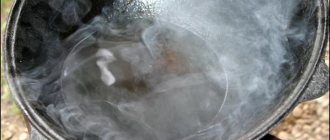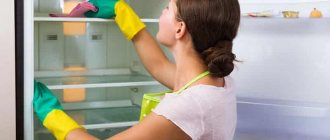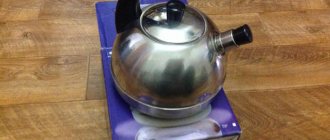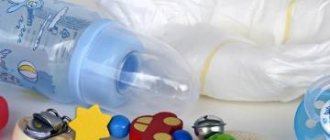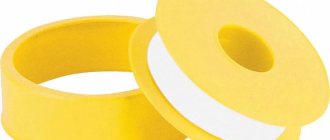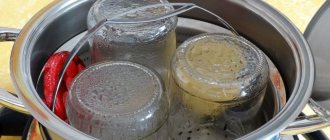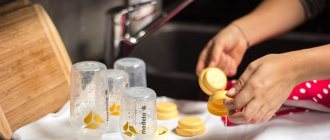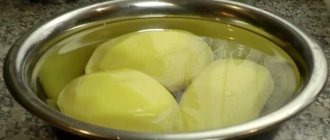After birth, a baby needs a mother. Not only for feeding, but also for comfort, emotional intimacy and relief. A mother cannot physically be constantly with her baby and offer the breast for any reason. Many babies have a very pronounced sucking reflex. They put everything into their mouths: clothes, diapers and their own fingers. It’s at moments like these that you wonder how to choose a pacifier for your child and how to properly sterilize it.
Sterilization methods
- The most common and accessible method for everyone is boiling. In this case, place the bottles washed in the sink into a container of boiling water and leave for 7-10 minutes. After which the dishes are removed and placed on a clean, dry towel. Sterilization of nipples takes place in the same way in a separate pan or other container;
- Modern parents often use a microwave oven for sterilization. This is a quick, easy and practical method in which the dishes are placed in a container, filled with water and closed tightly with a lid. Then put in the microwave for 5-6 minutes;
- For cold sterilization, special antiseptic tablets are used. Such products are distinguished by a high degree of disinfection and ease of use. They reliably and efficiently eliminate harmful bacteria and preserve the appearance of products, whereas they can deteriorate when boiled or sterilized in the microwave. To prepare the solution, one tablet is dissolved in cold water in which the baby’s dishes are placed and left under a closed lid for at least 30 minutes;
- A double boiler and multicooker are another modern method of processing and sterilization. Water is poured into the lower compartment of the steamer, where the bottles are placed upside down. The nipples are retracted into the upper part of the device. The dishes are sterilized using the “Cooking” mode for about ten minutes. To process dishes in a multicooker, place the items on a wire rack, pour a liter of water into the machine’s container and leave for ten minutes in the “Steam” mode;
- Today, manufacturers offer an electric steam sterilizer, which is designed specifically for sterilization, disinfection and disinfection of dishes and other items. The products are placed in the device, filled with water and the desired mode is selected. The process takes about ten minutes, and the device can accommodate up to six products at a time.
How to ensure sterility when away from home?
Very often there are situations when using popular methods of killing bacteria is impossible. For example, this is possible on long trips, vacations in the country or in nature. Then the sterility of bottles, pacifiers and other items for feeding and caring for newborns must be ensured in advance.
First of all, you should prepare a package with items for the procedure. For example, in a hospital you can use the sterilization method in a microwave oven, in the countryside - using water and antiseptic tablets. Sealed bags and containers are suitable for transporting already sterilized dishes. Specialized hygiene items can be purchased at a children's store or pharmacy. They can be used up to twenty times.
Sterilization methods
Boiling
The disadvantage of this sterilization method is the reduction in the service life of the product, since over time the plastic part may be subject to deformation from high temperatures.
It is important to consider the material from which the pacifier is made. Silicone and latex are used in their production
Latex pacifiers do not withstand long-term heat treatments, wear out quickly and attract dust. Silicone ones are wear-resistant and more hygienic.
Steam appliances
They are used not only for processing feeding bottles, but also pacifiers. Exist:
- ultraviolet;
- electrical;
- steam sterilizers for microwave ovens.
They are convenient because the sterilization time can be controlled and the product does not burn, as can happen when boiling.
Electric and microwave sterilizers have in common the need to use water.
IMPORTANT. When choosing a sterilizer for a microwave oven, make sure that it fits the size of your microwave oven
Algorithm of actions:
- Pour the required amount of water into the sterilizer.
- Place pacifiers in it.
- Close the lid and microwave for 2-6 minutes.
- Once the process is complete, open the lid and remove the products. If you need to maintain sterility for some time, leave the sterilizer closed.
The advantage of this method is that sterility can be maintained for up to 24 hours with the lid closed. Such sterilizers are convenient because they are light in weight and do not take up too much space.
One of the disadvantages is that not everyone has a microwave oven.
Electrical devices
- Fill the tank with the required amount of water.
- Place the pacifiers into the device.
- Connect the device to the network.
- Set the required time for sterilization, which varies from 8 to 10 minutes.
- Remove the pacifiers with tweezers.
The undoubted advantage of this method is that the process is automated.
The downside is the large size of the devices and not every apartment has room for it.
Ultraviolet devices
Most often they are portable and run on batteries. And their compact size allows you to carry such a sterilizer with you and process the pacifier as soon as necessary.
- Place the pacifier in the sterilization compartment and close the lid.
- The lamp will be active for 6 minutes, after which the device will turn off automatically.
- Remove the nipples and place them in a container.
The advantage of this method is that the process does not require water, and ultraviolet radiation has an additional bactericidal effect. Ultraviolet light destroys more than 99% of bacteria.
Multicooker
A convenient way to sterilize pacifiers is to process them in a slow cooker.
- Rinse the multicooker bowl thoroughly.
- Pour 1 liter of filtered water into it.
- Place a steaming rack.
- Place the nipples on the rack.
- Set the “Steam cooking” mode for 10-15 minutes. If there is a “Sterilization” mode – 7-10 minutes.
- Once the process is complete, remove the nipples with tweezers and place them in a clean container.
Double boiler
- Pour water into the lower compartment of the device.
- Place the nipples on the top tier.
- Set the “Steam cooking” mode for 5-15 minutes.
- Remove the nipples with tweezers after the process is completed.
The advantages of these methods are the automation of the process. Hot steam destroys pathogenic microorganisms, which is the key to the baby’s health. You can sterilize pacifiers in the microwave.
ATTENTION. When choosing this method of sterilization, carefully read the instructions for the pacifier, make sure that this method of processing is acceptable
- Use a microwave-safe, heat-resistant bowl. Most often these products are made of thick glass.
- Place the nipples in a bowl and fill them with water so that it completely covers the product.
- Place the dishes in the microwave.
- Sterilize at maximum power for 6-8 minutes.
- Remove the nipples from the water with tweezers and place them in a container.
The advantage of this method is that it does not take much time, but it sterilizes just as well.
One of the disadvantages is that there are many prejudices about the dangers of microwave oven radiation.
Chemical method
Tablets for treating baby nipples are offered by Bebe Confort and Milton.
- Prepare a clean 5-liter container by rinsing it with boiled water.
- Dissolve one tablet of the product in 5 liters of water.
- Place pacifiers in the solution for 15 minutes and cover the container.
- Remove and dry the nipples.
The advantage of this method is that the solution can be used within 24 hours and the nipples can be removed only when the child needs it. The possible odor remaining on the pacifiers can be a disadvantage.
Microwave
Should I sterilize my pacifier in the microwave? If the instructions for use do not indicate the possibility of using a microwave oven, then it is better not to do so. Plastic bottles and latex nipples can quickly become unusable.
You can only use the microwave to sterilize glass bottles for drinking and feeding.
The dishes should be placed in the oven, pour water to a third of the volume. Then you need to set the maximum power. Sterilization time is 2 minutes. Drain the water and let the bottle cool to prevent the glass from cracking.
Processing utensils before sterilization
Every housewife knows, but you should not use ordinary detergents for children's dishes. The composition of such liquids can be dangerous for the baby. Some ingredients can cause allergic reactions that are extremely undesirable for a child.
Children's things, whether diapers or dishes, must be treated with special means. Although they are not suitable for every baby.
Old proven products are absolutely safe to use: laundry soap, soda and mustard powder. These products are hypoallergenic and help achieve results.
However, we must remember that soda can destroy latex. Therefore, using it to wash nipples is undesirable.
Rules to follow when processing baby dishes and pacifiers:
- Rinse all parts of the pacifier thoroughly.
- If a white coating appears inside the latex balloon, then the pacifier is unsuitable for use.
- Bitten and cracked accessories should not be given to the baby.
- Wash milk bottles until shiny. After washing, wipe with table salt and rinse with clean water.
- Be sure to sterilize all utensils and nipples.
- Do not use chemicals to wash dishes and pacifiers.
For or against
Regarding whether it is necessary to boil baby bottles and pacifiers after each use, experts sometimes hold directly opposite views.
Some pediatricians (in particular, the country-famous Dr. Komarovsky) believe that excessive sterility is more likely to harm babies, causing:
- decreased immune status, which weakens without the need to strain in the fight against pathogens,
- the occurrence of various allergies, which is also explained by a general weakening and lack of training of the immune system.
In their opinion, it is enough to simply wash a pacifier or bottle well under running water, then rinse with boiling water, and sterilization of baby utensils for a newborn is only necessary if milk is to be stored in it.
But is it possible, based on this, to say that sterilizing bottles for newborns is not such a mandatory process?
In addition, sometimes it happens that the electricity in the apartment is turned off for a long time, as a result of which the milk mixture in the refrigerator turns sour and stinks. The smell of sour milk is very persistent, it is perfectly preserved in the bottle; it is not possible to get rid of it and completely wash baby bottles of plaque by simply rinsing - they need to be thoroughly disinfected.
Thus, it is not possible to completely abandon disinfection, and every young mother wants and should know how to properly sterilize bottles.
Features of nipples made of different materials
Features of nipples made of different materials need to be sterilized in different ways. Nipples are often divided into two types; they can be either rubber or plastic. Rubber ones are more convenient because completely different methods can be used to sterilize them. As for plastic ones, the situation with them is more complicated, and in order to have an idea of how to sterilize them, it is first of all advisable to consult with the seller or a representative of the manufacturer.
Nipples can be made from several materials:
- latex;
- silicone.
The first type is ideal for newborns, all because they are distinguished by their softness and lack of rubbery taste. Silicone nipples are more rigid, but they are ideal for those babies who are prone to allergies and who have already started teething.
Antiseptic tablets
At home, you can use special antiseptic tablets or powders, for example, JEX. Their use will not cause any problems:
- pour cold water into a container of a suitable size (bowl, pan);
- dissolve a disinfectant in water;
- place baby dishes, pacifiers, pacifiers into the solution;
- cover the container with a lid and leave for half an hour;
- After 30 minutes, remove all items and rinse with clean boiled water.
Despite its apparent simplicity, this method of sterilization is not very popular among modern parents: some are afraid to use chemicals, others do not want to spend money on buying tablets and powders. This type of disinfection also has its supporters: the treatment process does not require boiling water, and the prepared antiseptic solution retains its properties for 24 hours. Tablets are convenient to use outside the home when other methods of sterilization are not available, for example, when traveling.
For the first months of life, the baby should be in an environment that is at least close to sterile. Therefore, a baby pacifier should not be given to a child again, especially if it has fallen, or licked by an adult.
The infant's immune system is not yet mature and cannot resist various microorganisms. The baby gradually adapts to new conditions, so while he is lying in the crib, pacifiers must be sterilized before use.
The newborn is given only a new pacifier, which is washed in a soapy solution before the first use and then sterilized. Store sterilized pacifiers in a sterile jar with a lid with an air hole.
Every two hours the child should be given a sterilized pacifier. There should be 2-3 of them so that the baby can use it or if it falls.
Replace pacifiers as they wear out, usually every two months.
Antiseptics
For emergency cases, when a clean pacifier is needed and sterilization is not available under normal conditions, special antiseptics are used. This is a pharmaceutical drug that needs to be diluted in cold water. This method causes a lot of controversy.
The antiseptic tablet is diluted according to the instructions. The pacifier should be placed in the solution for 30 minutes. The need for rinsing reduces sterility. And although the drugs are harmless, the child may refuse the pacifier treated in this way. In addition, the chemical composition of the antiseptic can cause allergic reactions in children.
When asked whether the pacifier needs to be sterilized, doctors give an unambiguous answer in the affirmative. Despite the fact that this is a troublesome matter, sterilization will protect the baby from many health problems.
Why do you need to sterilize baby equipment?
A child’s body develops and improves over the course of one to two years, and therefore it is extremely susceptible to various diseases, including infectious ones. If you do not follow the basic rules of sterilization, this can result in serious illnesses, food poisoning with severe symptoms (nausea, severe vomiting, bowel dysfunction, high fever, etc.). To restore the child’s health, he will have to be admitted to the hospital. Any mother is unlikely to want this, and therefore it is better to be safe. For the first months of life, the baby should be in an environment that is at least close to sterile. Therefore, a baby pacifier should not be given to a child again, especially if it has fallen, or licked by an adult.
The infant's immune system is not yet mature and cannot resist various microorganisms. The baby gradually adapts to new conditions, so while he is lying in the crib, pacifiers must be sterilized before use.
The newborn is given only a new pacifier, which is washed in a soapy solution before the first use and then sterilized. Store sterilized pacifiers in a sterile jar with a lid with an air hole.
Every two hours the child should be given a sterilized pacifier. There should be 2-3 of them so that the baby can use it or if it falls.
Replace pacifiers as they wear out, usually every two months.
There are no advantages at all?
Studies have found a link between pacifier use and a lower risk of sudden infant death syndrome (SIDS). Among children who are offered a pacifier, SIDS is 90% less common compared to children who did not suck a pacifier. This dependence was stronger when the child's sleep conditions were incorrect: sleeping on his stomach or side, sleeping with a smoking mother, or on a soft bed. However, researchers have not been able to understand the mechanism of this effect.
Sucking, not for the purpose of satiation, but for the sake of the action itself, is associated with better growth and higher resistance of the body of premature babies. In this regard, the pacifier can be an alternative if breastfeeding is not possible.
How to properly sterilize a pacifier before first use, processing methods
In the first months of life, it is important that the child grows up clean. An indispensable attribute of a baby is a pacifier.
During the day, the little fidget drops it a large number of times.
It is important to clean the pacifier after falling, as pathogenic bacteria rush to the “target” with lightning speed. So, does it need to be processed over and over again, or is simple rinsing enough, and how to sterilize the pacifier before the first use, we will consider further
So whether it is necessary to process it over and over again, or simple rinsing is enough, and how to sterilize the pacifier before the first use, we will consider further.
Why treat a pacifier before first use?
At every step, the baby is lurked by bacteria that a weak immune system cannot cope with on its own. Therefore, the efforts of a young mother should be aimed at organizing everyday life for the comfortable development of her child. The answer to the question about sterilizing a pacifier is clear - it is worth sterilizing - both before the first use and subsequently.
Processing dishes before sterilization
It is important that the dishes in which the first and subsequent sterilizations will take place are processed. Conventional detergents used in everyday life are not suitable for children's dishes, as they have a chemical composition and, if not processed carefully enough, lead to allergic reactions and even dysbiosis
Laundry soap and soda are safe for children's dishes. They are not capable of leading to allergic reactions, but do an excellent job of disinfection. To process dishes for further safe use, you must follow the following recommendations:
- all parts of the bottle must be individually and thoroughly washed;
- the pacifier is unusable if a white coating has formed inside the silicone cavity;
- if a baby bites through a favorite attribute, it can no longer be used;
- Both nipples and bottles should be sterilized;
- It is strictly prohibited to use “adult” chemicals to clean dishes.
If you follow these simple rules, sterilization of nipples and bottles will be successful.
How to sterilize baby pacifiers?
There are many ways to sterilize nipples. Let's consider the basic methods, proven over the years and by experienced mothers.
In a steamer or dishwasher
Automated household appliances are excellent assistants in sterilizing pacifiers. An electric steamer has a number of advantages. It makes it possible to set the temperature and time mode, and also quickly copes with the task.
Can bottles and nipples be sterilized in the dishwasher? The answer is yes if the dishwasher is equipped with a setting greater than 80 degrees. At lower temperatures, sterilization will not occur, and the material will wear out from time to time.
Using a sterilizer
Of the household items listed above, the most suitable for cleaning bottles and pacifiers is a sterilizer. It is easy to use, affordable and perfectly destroys bacteria using an ultraviolet lamp.
We treat with antiseptics
An antiseptic is a drug that you can purchase at a pharmacy, used to disinfect household items, and has a chemical composition.
Application: dissolve the antiseptic tablet in a five-liter container of water, immerse pacifiers or bottles in water for 15 minutes, then rinse with boiled water. It would seem that the job is done, the microbes are killed, and this is so. However, after using the antiseptic, an unpleasant odor remains, due to which the baby may refuse the pacifier.
What to consider when sterilizing nipples
There is no consensus on how often the pacifier should be sterilized. Some are of the opinion that boiling is only necessary when purchasing an attribute or when the baby is ill, while other parents sterilize bottles and nipples several times every day.
It is important to follow the following rules:
- Keep disinfection utensils clean and boil before use.
- Boiling for a few minutes is the key to a clean pacifier. Bacteria do not live at high temperatures for more than a minute.
- All parts of the pacifier should be sterilized, not just the latex or silicone part.
- Rinsing with cold tap water is unacceptable and can lead to dysbacteriosis.
With the birth of a baby, many questions and doubts arise about how to properly care for him so as not to harm him. Sterilizing the pacifier is no exception. Each mother chooses one method or another. But it should be remembered that cleanliness is the key to the health and well-being of the child.
Frequency
Every pediatrician tells mothers about the need to buy a sterilizer for children's dishes. They recommend sterilizing glass and plastic bottles.
How often should this be done? For a newborn, cleanliness both in the house and in the dishes is important. It is necessary to sterilize after each feeding, and not skip the procedure. This is what most pediatricians recommend.
In fact, such a procedure does not have to be carried out after every feeding. Once a week should be more than enough to prevent uncontrolled bacteria formation.
Until then, you have high-quality and good water that you buy for your baby, you don’t need to boil it too often, just wash it properly.
Sterilizing daily is not recommended because this procedure can potentially damage the bottle and allow chemicals to leach BPA into the milk.
The Food and Drug Administration (FDA) has banned the use of bisphenol A, or BPA, due to the chemical's effects on baby development. If you are using older baby dishes, make sure they do not contain this synthetic estrogen.
If you use a dishwasher with hot water and a heated dry cycle to clean everything, there is no need to sanitize by hand.
If you decide to sterilize regularly, this is normal, and you should not rely on others. The procedure can be performed frequently for up to 3 months. During this time, the child's immune system is already slightly developed and can protect him from infections.
Many pediatricians advise carrying out the procedure during the first year of the baby’s life. Usually during this time the immune system is fully formed and boiling is no longer required.
How often should pacifiers and bottles be sterilized?
I think you understand how to boil a pacifier and bottle
, now we need to tell you how often this process should be repeated. If you feed your baby only artificial formulas, then the bottle should be boiled before and after each feeding, this will provide the baby with maximum protection from harmful bacteria that disrupt the microflora and provoke infectious diseases such as dysentery. Often, leftover food is a favorable environment for the active reproduction of viruses and bacteria. If you do not sterilize the bottle in time, then at the next meal they will all enter the child’s body. Because of this, the baby may develop diarrhea, serious intestinal disorders, etc. It is necessary to sterilize dishes for at least one year, or until the baby refuses the bottle. Over time, the child’s body will begin to produce immune cells that will independently fight microbes that cause an imbalance in the internal microflora.
Adviсe
Under no circumstances should you give your child a pacifier that has simply been rinsed with clean water. Even using bottled water can cause gastrointestinal upset in your baby. A child’s delicate body is not able to fight all microorganisms contained in raw water.
It is absolutely unacceptable to give a baby a dropped pacifier, just by wiping it with a handkerchief, for example.
Some mothers manage to put a pacifier in their baby's mouth by licking it. The bacteria contained in saliva will definitely reach the baby. The microflora of an adult can be dangerous for a newborn.
Mixed feeding after returning from the maternity hospital
After you have given your baby colostrum - the first milk containing many nutrients and antibodies - you can move on to mixed feeding. However, keep in mind that when your baby nurses less, your milk supply may decrease unless you stimulate it further with a breast pump.
In all cases, if you are adding formula to your breast milk within the same feeding, try to give your baby the breast first before moving on to the bottle whenever possible. At such times, ask someone else to give the bottle, not you, so that the baby will clearly remember the difference between the bottle and your breast. If you are adding the artificial mixture only in small quantities, we recommend using a pipette, syringe or teaspoon for this. This will prevent your baby from confusing the breast with the nipple of the bottle and will preserve his sucking reflex (which becomes much less pronounced when using a nipple through which milk flows without much effort).
Natural Recipes
Natural remedies to stop lactation The choice in favor of artificial feeding immediately raises the question of how to stop lactation. First of all, reduce your daily fluid intake (including infusions, tea, coffee and juices) to 2-3 glasses per day for 3-4 days. Instead of allopathic remedies, you can use effective natural medicines.
Homeopathy
“Lac Caninum 30 CH” and “Prolactinum 30 CH”: 1 dose of each drug in the morning and evening for 4-8 days. When temporary swelling appears: “Belladonna 9 CH” and “Bryonia 9 “o* CH”: 3 granules of each drug at least 4 times a day.
Phytotherapy
Use plants that gently remove “water” from the body: nettle, the drug “V. 0. R." and etc.
If your breasts are painful, take a very hot shower (without a massage effect), then apply Z-trauma gel, Osmogel, or arnica oil mixed in a ratio of 92%: 8% (that is, 25 drops per 50 ml bottle) with the following essential oils: real or medicinal lavender, rosemary (containing the compound 1,8 cineole), fragrant pelargonium.
UpSize is an effective breast enlargement product on the market
Many modern women are faced with the need for aesthetic bust modeling. Almost everyone wants luxurious shapes. And it’s not surprising, because the neckline has always been an area of increased attention for men.
As a result of daily use of the cream, after 3-4 weeks the volume of the breast increases, the shape becomes more rounded and toned; the skin is elastic and velvety.
The cream has undergone clinical trials conducted by specialists from the World Health Organization in 14 countries. Thousands of women have been convinced of the effectiveness of UPSIZE cream.
- Deoximiroestrol
has a pronounced rejuvenating effect, promotes breast growth;
- Pueraria Mirifica Root Extract
effectively nourishes and protects the skin;
- Rose essential oil
increases skin firmness and elasticity, eliminates and prevents stretch marks.
We recommend!
Do you look with envy at busty beauties who, with just their appearance, attract all the looks of men? And they seem to have some kind of natural femininity. But a small bust is no longer a death sentence! Find out how to enlarge your breasts once and for all... Read more »
(function(w, d, n, s, t) { w = w || []; w.push(function() { Ya.Context.AdvManager.render({ blockId: 'RA-449633-8', renderTo : 'yandex_rtb_R-A-449633-8', async: true }); }); t = d.getElementsByTagName('script'); s = d.createElement('script'); s.type = 'text/javascript '; s.src = '//an.yandex.ru/system/context.js'; s.async = true; t.parentNode.insertBefore(s, t); })(this, this.document, 'yandexContextAsyncCallbacks '); (function(w, d, n, s, t) { w = w || []; w.push(function() { Ya.Context.AdvManager.render({ blockId: 'RA-449633-10', renderTo : 'yandex_rtb_R-A-449633-10', async: true }); }); t = d.getElementsByTagName('script'); s = d.createElement('script'); s.type = 'text/javascript '; s.src = '//an.yandex.ru/system/context.js'; s.async = true; t.parentNode.insertBefore(s, t); })(this, this.document, 'yandexContextAsyncCallbacks '); (function(w, d, n, s, t) { w = w || []; w.push(function() { Ya.Context.AdvManager.render({ blockId: 'RA-449633-22', renderTo : 'yandex_rtb_R-A-449633-22', async: true }); }); t = d.getElementsByTagName('script'); s = d.createElement('script'); s.type = 'text/javascript '; s.src = '//an.yandex.ru/system/context.js'; s.async = true; t.parentNode.insertBefore(s, t); })(this, this.document, 'yandexContextAsyncCallbacks ');
(function(w, d, n, s, t) { w = w || []; w.push(function() { Ya.Context.AdvManager.render({ blockId: 'RA-449633-3', renderTo : 'yandex_rtb_R-A-449633-3', async: true }); }); t = d.getElementsByTagName('script'); s = d.createElement('script'); s.type = 'text/javascript '; s.src = '//an.yandex.ru/system/context.js'; s.async = true; t.parentNode.insertBefore(s, t); })(this, this.document, 'yandexContextAsyncCallbacks ');
Processing and storage
The only danger that can await children and parents using them is the possibility of contracting an infection due to improper handling. Constantly treating your nipples will help you easily avoid this problem. Before electric appliances, parents simply boiled them. Now there are enough ways to sterilize nipples for newborn babies.
In order to always have a clean one at hand, you need to have 3-4 pieces in stock. To store sterile items, you can prepare a regular glass jar with a lid. How often sterilization will need to be done depends on how many pacifiers are available and how often the child uses them.
Kinds
What types of pacifiers and pacifiers are there?
- Latex. Very soft and comfortable devices. With constant sterilization, latex breaks down and becomes unusable. Needs to be changed every 2 weeks.
- Silicone. Quite durable nipples that are not subject to deformation when sucking. They have no foreign odors. The use of these pacifiers is recommended until the first teeth appear. The material is easily bitten by children, and pieces can get into the throat. They will have to be changed approximately once a month.
Should you give a pacifier to your baby?
Disputes on this matter do not end to this day. Some pediatricians say it is necessary. Other doctors do not recommend it. It is only known that all children are individual and the sucking reflex in each baby is expressed to varying degrees.
Another well-known fact: pacifiers were invented a long time ago. Children were given a piece of bread wrapped in cloth or a piece of leather to suck on. Modern objects to satisfy the sucking reflex began to be produced only around 1900.
Features of pacifiers made of different materials
Currently, pacifiers are made from two materials: silicone and latex. It is not difficult to distinguish them. Silicone nipples are transparent, stiffer, but also more durable. Latex pacifiers are yellow in color, they are soft, more reminiscent of a woman's breasts to the touch, but they wear out quickly and have an odor. Both are quite durable. When it comes to cleanliness, silicone pacifiers are more hygienic as they collect less dust, hair and dirt.
These two materials behave differently in sterilization. Silicone pacifiers can withstand repeated boiling without visible changes. But latex nipples do not have these qualities. They are, of course, heat-resistant, but prolonged boiling can ruin it. Therefore, latex pacifiers need to be changed more often. According to the instructions, the service life of a silicone pacifier is 6 weeks, and a latex pacifier is 4 weeks.
Conclusions:
- Silicone pacifiers are heat-resistant, durable, rigid, hygienic and transparent.
- Latex nipples - do not withstand long-term temperature treatments, wear out quickly, are soft (babies like them more), attract dust and have an odor.
How to choose the right pacifier for a child?
Small children do not care at all whether their pacifier is latex or silicone. But when the time comes for teething, it is better to offer a latex pacifier. It is softer and will not in any way affect the bite or position of the teeth.
Types of pacifiers
Few people know, but nipples vary in shape and size. You can’t just go to a pharmacy or children’s store and buy a “breast substitute.”
The shapes of pacifiers are: round, oval and orthodontic. If in the first two cases everything is more or less clear, then with the third, questions arise. These are nipples whose silhouette resembles a mother's breast. More precisely, it has a thin neck and a beveled tip. Pediatricians recommend buying pacifiers with a flat end to form the correct bite.
In addition to differences in shape, there are “substitutes” of all sizes that correspond to different ages. For newborn babies, pacifiers are very small. It’s easy to find the right size by reading the instructions on the package.
To determine which model is right for your baby, you need to try several types of pacifiers.
Flaws
It is with great regret that there are a few more negative aspects to using nipple shields. This:
- decreased production of mother's milk. Because of them, oxytocin is released to a lesser extent, on which lactation depends. This may cause complications with breastfeeding for the mother, and weight gain for the newborn;
- long-term use causes addiction in the child. The baby is no longer ready to show strength when feeding - he refuses the breast, and the mother has to feed the baby from a bottle;
- the use of overlays for cracked nipples is not always necessary; it often leads to the opposite effect, aggravating the problem;
- If the material or shape of the product is incorrectly selected, there is a high probability of harming the breasts. Abrasions, chafing appear, compression of the nipple or areola occurs;
- These breast devices negatively affect the baby’s digestive system. Because the baby sucks the silicone substitute more intensely, air gets in more often, which causes colic, increased gas formation, and regurgitation;
- this method of feeding is unacceptable in public places, since it is inconvenient to constantly wear them on the street or at night;
- it is possible to become infected with an infectious disease for both mother and child. If the product is processed poorly through the oral cavity, the disease can be transmitted to the baby, while the mother has a risk of contracting fungal diseases due to cracks in the nipples.
Among the variety of pads from different brands, any nursing mother, if necessary, will choose exactly what she needs.
